Get rid of the plug! Make wireless charging for electric vehicles a reality now!
Unique components ensure safety, efficiency and reliability.
Imagine an EV charging experience that’s as seamless and simple as parking your car – just “park, charge, go.” For the end user, the appeal is clear:
No more heavy cables No fumbling with connectors No exposure to potentially dirty or damaged charging equipment
EV owners envision walking into their garage, designated parking space, or public charging station and effortlessly charging their vehicle without leaving the driver’s seat. This convenience makes everyday charging easier to use and enhances safety by completely removing physical connectors.
Understanding this user-centric view is critical for designers of wireless electric vehicle charging systems. By providing efficient, reliable and fast wireless charging, designers can unleash game-changing benefits that combine ease, convenience and peace of mind for electric vehicle drivers.
While current wireless electric vehicle chargers can provide up to 20 kilowatts of battery charge in four to six hours, future wireless chargers will deliver 100 kilowatts and be able to increase a battery’s state of charge by 50 percent in less than 20 minutes.1
Wireless charging stations must be fast, safe, efficient and reliable to accelerate adoption.
This article explores the technical considerations and innovative approaches required to achieve this experience, ensuring that wireless charging solutions meet performance and user expectations in the ever-evolving electric vehicle landscape. It offers four components that meet the basic needs of creating designs that ensure charger circuit protection, safety monitoring, and fast and efficient power delivery.
Description of wireless charger
The wireless charger is an AC-AC converter that converts 50/60Hz power into power in the 130kHz frequency range. The resonance frequency depends on the topology and power semiconductor technology (Si/SiC/GaN). Power delivery can reach 20 kW. Figure 1 shows the wireless charger and its payload, EV. The main power and control circuit blocks of the charger and vehicle are also defined.
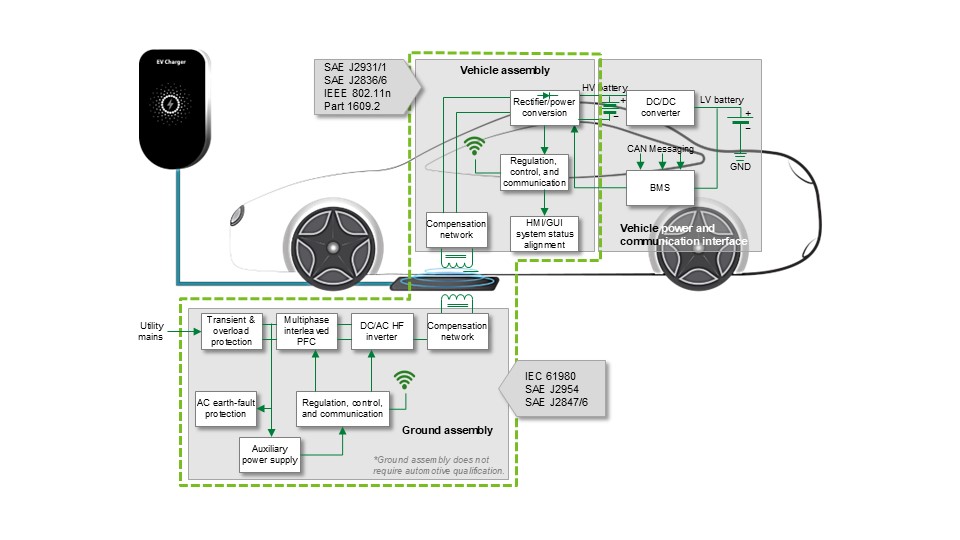
Safety and reliability considerations include over-current protection, over-voltage protection, over-temperature, and ground current monitoring. Improving efficiency requires a design with low power loss components. Figure 2 shows the components that provide circuit protection and high efficiency circuits for a typical wireless charger design. Sensors provide temperature monitoring and enclosure access protection.
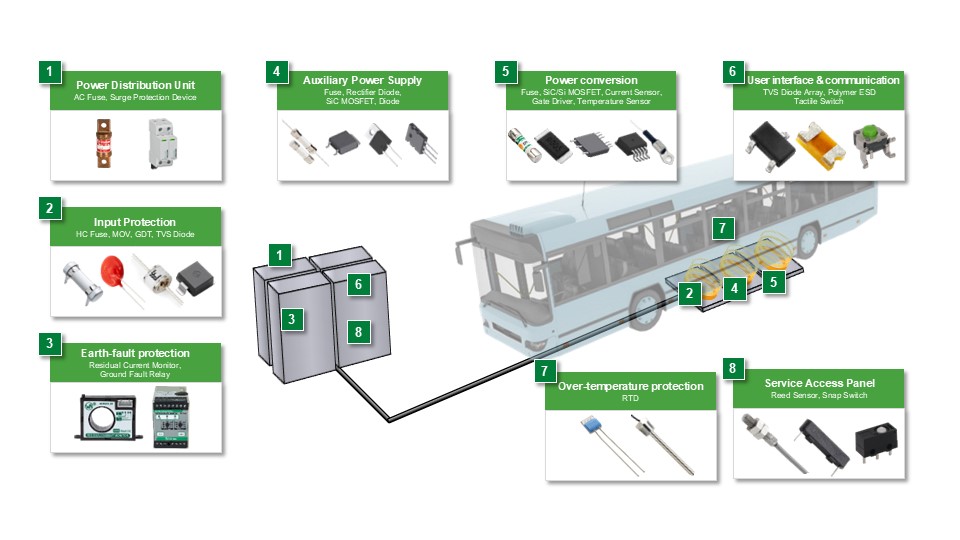
Figures 3 and 4 show an example of a wireless charger in a more detailed diagram. The adjacent table in Figure 3 lists the components that provide the charger with protection from electrical hazards. Figure 4 shows primarily the components that produce efficiency and critical sensing.
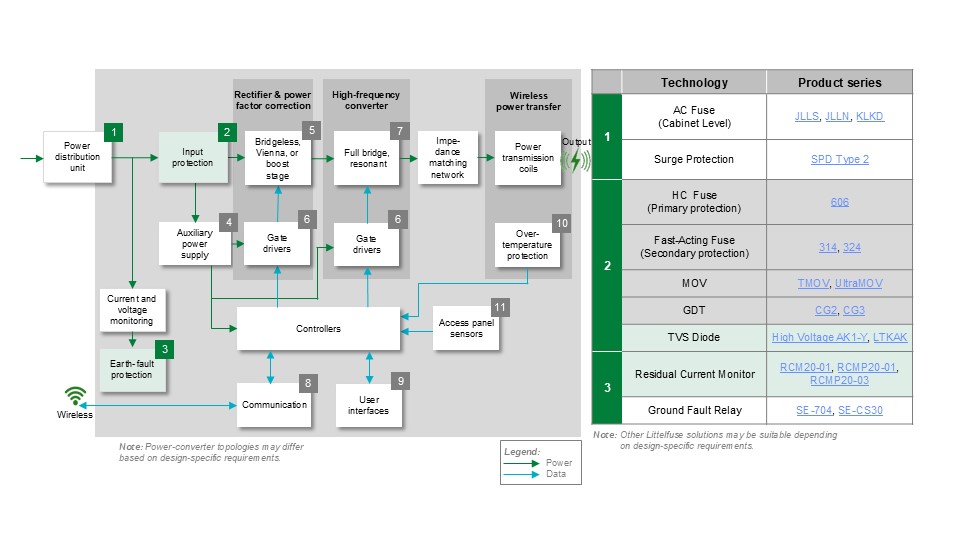
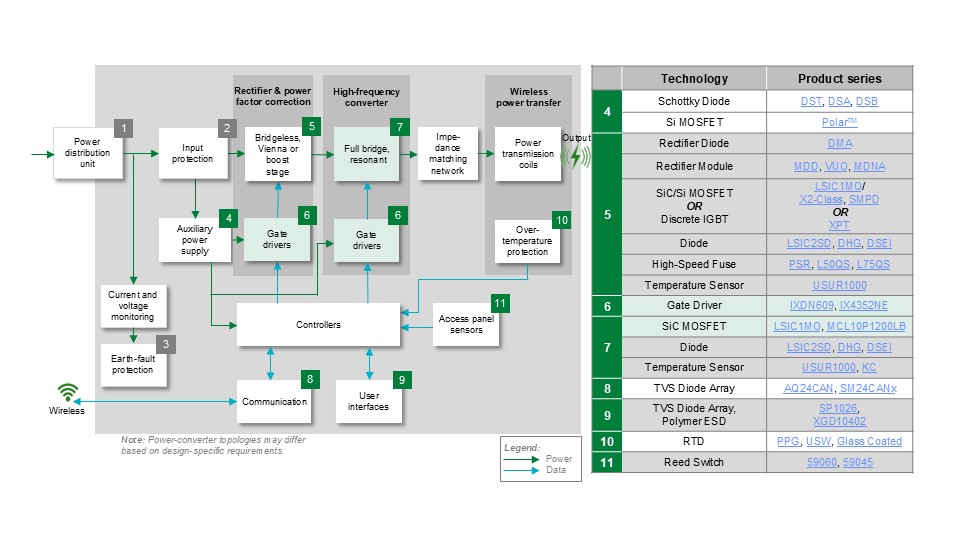
Circuit protection and safety components
The input protection circuit contains the main components for over-current and over-temperature protection. Recommended components include a high-current fuse for the power supply circuits and a fast-acting fuse to protect the low-power auxiliary power supply and control circuits. A metal oxide capacitor (MOV) in series with the gas discharge tube absorbs the overvoltage transients. Transient overvoltages are caused by lightning which can lead to voltage surges on the AC input lines. In addition, turning electrical loads on and off can increase the AC line voltage.
The special component that can pick up parts of the transient voltage that passed through the MOV tube and the gas discharge tube is a transient voltage suppressor (TVS) diode. TVS diodes have lower clamping voltage, and operate much faster than MOV devices. Special diodes can ensure the protection of the final circuits. They can absorb a single kiloampere pulse and respond to a transient wave in less than one nanosecond. TVS diodes can provide protection from through-the-air electrostatic discharge (ESD) at voltages up to 15 kV and from direct contact discharge up to 8 kV. Bidirectional models and models are available that are less than one-tenth the size of traditional discrete solutions. TVS diodes can have coaxial lead or surface mount form factors. Figure 5 shows the TVS diode and its functional diagram, using Littelfuse’s AK1-Y series TVS diode as an example. This component will provide the necessary protection from both ESD and other transients to avoid damage to the semiconductor circuits in the wireless charger.
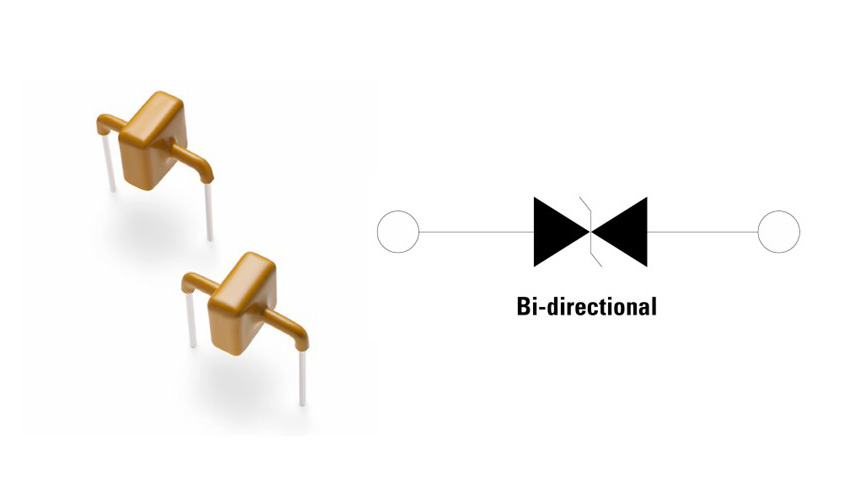
With systems such as wireless electric vehicle chargers, monitoring ground currents is essential to protect personnel. The ground fault protection circuit performs the function of monitoring the ground current. Littelfuse introduces new residual current monitors for this circuit that detect both AC and DC ground fault currents. The new series, the RCMP20 Residual Current Monitor Series for Mode 2 and Mode 3 wireless charging stations, provides the largest current adapter slot to support higher AC charging currents. Residual current monitors have sensitive typical trip thresholds of 4.5 mA DC and 22 mA AC. Furthermore, the displays use integrated conductors with higher cross-sectional areas to provide better thermal management and reduce printed circuit board (PCB) temperature rises. The result is a more compact and reliable design that does not compromise performance. In addition, the displays have high immunity to electromagnetic interference (EMI), which improves charger circuit reliability and reduces circuit false trips. Screens can be mounted either horizontally or vertically to allow designers flexibility to optimize use of space. Figure 6 shows the models in the residual current monitoring chain. (Watch the video.)
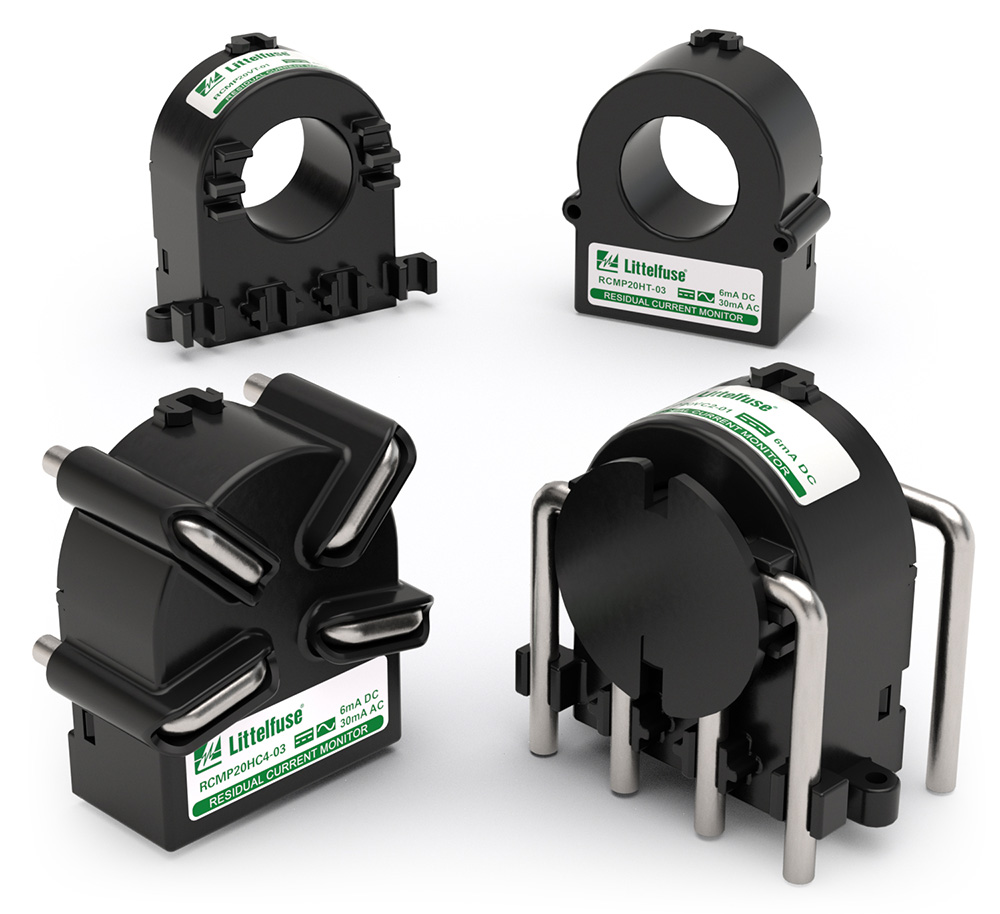
Components for maximum efficiency and reliability
Systems, such as wireless charging systems, consume a lot of power. Optimizing design for efficiency reduces energy consumption and utility costs and reduces heat buildup. The lower heat generated reduces the internal temperature rise in the system and enhances system reliability. The use of two components in the power delivery circuit can contribute to increased efficiency and reliability. The two components are gate drivers and SiC MOSFETs.
Gate drivers control Power SiC MOSFETs and IGBTs in Bridgeless, Vienna, or Boost Rectifier, full bridge, and high-frequency resonant converter circuits. The drivers have 9 separate source and sink outputs, allowing programmable on and off timing while minimizing switching losses. The internal negative charge regulator provides a selectable bias to the negative gate drive for improved dV/dt immunity and faster shutdown. Gate drives reduce switching times with on-off propagation delay times of typically 70 and 65 nanoseconds. A typical value for the rise time and fall time outputs is ten nanoseconds.
To ensure robust operation, the gate drivers have a desaturation detection circuit which senses an over-current condition of the SiC MOSFET and initiates a soft shutdown. This circuit prevents a potentially harmful dV/dt event. Additional protection features include UV detection and thermal sealing. Figure 7 shows the Littelfuse IX4352NE SiC MOSFET and IGBT Driver IC, a high-speed gate driver with features that provide reliable control of the SiC MOSFET.
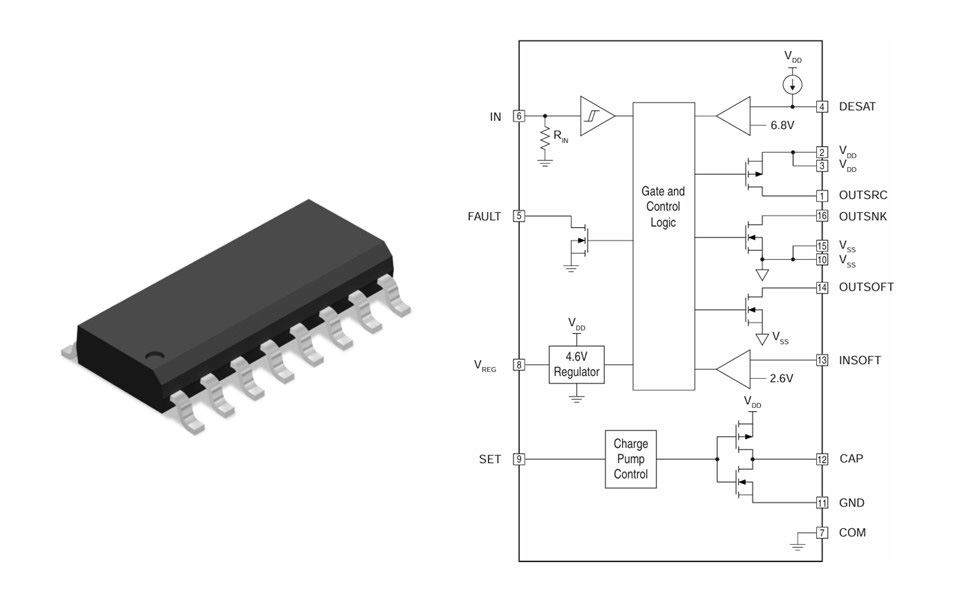
High-power SiC MOSFETs drive the power transfer coils. Half-bridge packages have a drain-source voltage of 1200 V and a drain current of up to 19.5 A. In addition to providing high power, the MOSFETs reduce case power consumption with a typical low RDS(ON) of 160 milliohms. SiC MOSFETs have low switching power losses due to the typical low gate charge, short turn-on times, turn-off delay times, and current rise and fall times.
DCB based insulated package improves thermal resistance and power handling ability. Advanced topside cooled package simplifies thermal management. The Littelfuse half-bridge SiC MOSFET MCL10P1200LB series, shown in Figure 8, produces high efficiency with advanced packaging to reduce the number of components and improve high reliability.
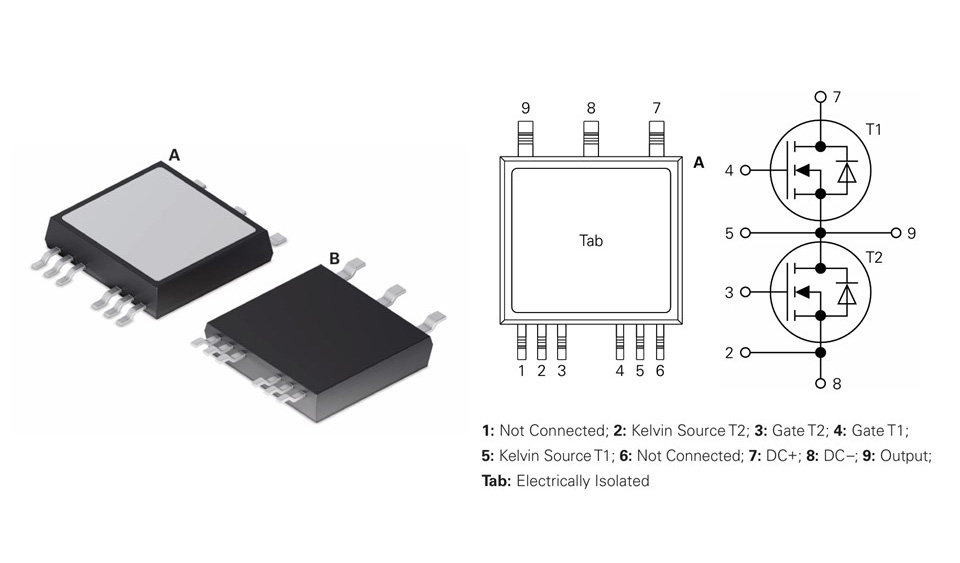
Work with the experts for a reliable wireless charging solution
Protection against electrical hazards such as over-current, over-voltage, electrostatic discharge and over-temperature is critical to ensure reliable operation. The four recommended components described in the previous paragraphs enable designers to develop robust, safe, and reliable wireless charging stations.
To develop a robust and efficient product, designers should consider using component manufacturers’ application engineers to save design time and compliance costs. Application engineers can help with the following:
Selection of high cost effective protection and sensing components. Knowing the applicable safety standards Littelfuse can perform pre-compliance testing to avoid compliance test failures and save project delays and additional costs of multiple compliance test cycles.
Collaborating with the component manufacturer’s application engineers and using recommended components will help produce robust, reliable, and efficient wireless charging solutions.
To learn more about circuit protection, sensing, and power management solutions for wireless EV charging design, download the guide, Supercharged Solutions for EV Charging Stations, presented by Littelfuse, Inc.
Contact Littelfuse for more information about making your wireless charging system design safe, efficient and reliable.
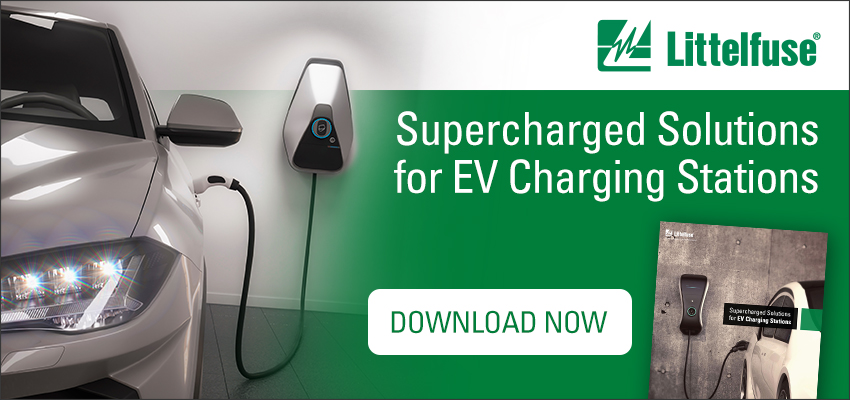
References:
1 litre. Blaine. The world’s fastest wireless charger for electric vehicles opens up parking spaces with a capacity of 100 kilowatts. New Atlas. March 18, 2024.




